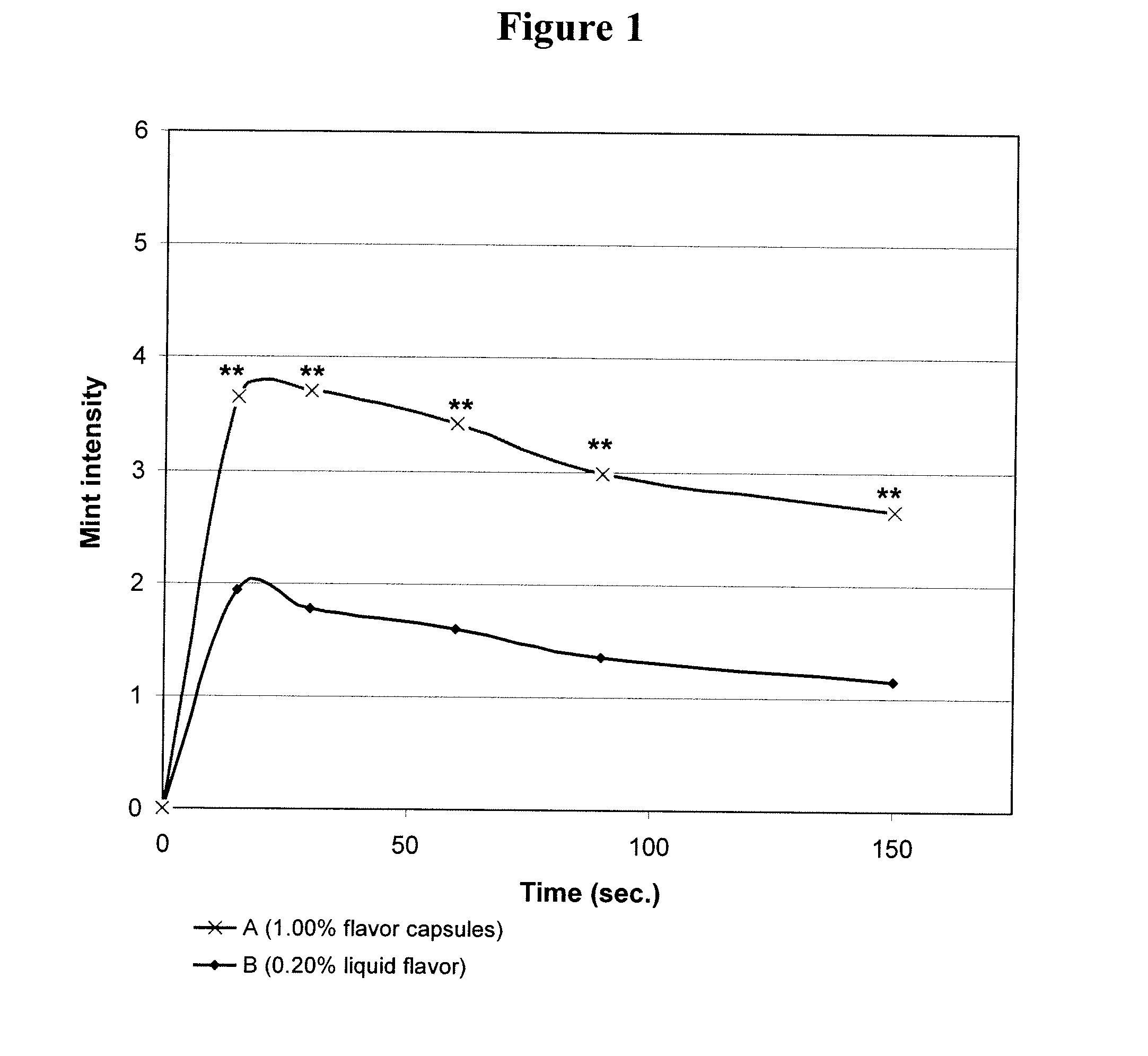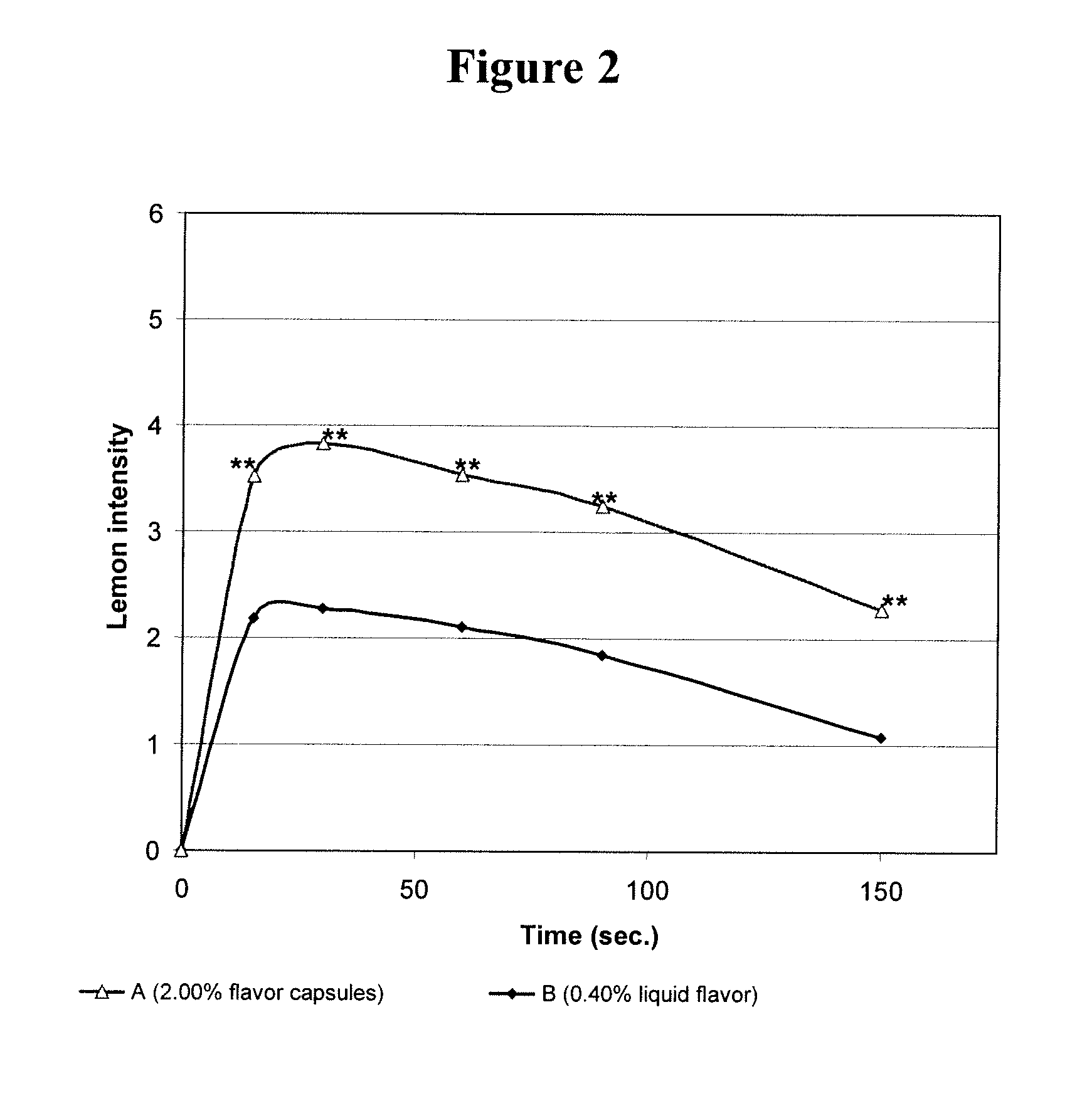Heated food product with coating of encapsulated flavors
a technology of encapsulated flavors and food products, which is applied in the field of preparing food products, can solve the problems of increasing the loss of flavor in heat-treated food, increasing the loss of flavor, and further loss through the degradation of sensitive flavor molecules, so as to increase the flavor performance of flavored food products and reduce the loss of flavor
- Summary
- Abstract
- Description
- Claims
- Application Information
AI Technical Summary
Benefits of technology
Problems solved by technology
Method used
Image
Examples
example 1
Preparation of Capsules Based on Yeast, Maltodextrin and Encapsulated Flavors
[0079] 100 g spray-dried yeast (Aventine Renewable Energy Company, USA) were dispersed in 375 g water. 75 g of flavor (NovaMint Freshmint®, commercially obtainable from Firmenich SA, Switzerland, commercial no. 506038T) are added and the mixture is maintained for 4 hours at 50° C. under constant agitation at 150 rpm in a blade stirrer.
[0080] Thereafter, 150 g of maltodextrin (DE 18) was added and mixed until the total aqueous mixture was homogenous.
[0081] The mixture was then spray dried on a Niro mobile minor® at 210° C. inlet and 90° C. outlet temperature at a feed rate of 10 ml / minute. A powder of capsules based on a micro-organism, a matrix component and at least one flavor are obtained.
[0082] The same procedure is repeated with a butter flavor instead of the mint flavor. Accordingly, 75 g of butter flavor (commercial no: 758904 06101TTB0440) commercially obtainable from Firmenich, Switzerland, was ...
example 2
Sugar-Free Chewing Gums Coated with Flavor-Capsules Based on a Micro-Organism and a Matrix Component
[0083] Sugar-free chewing gum pellets were prepared with the ingredients given below:
IngredientsPercent (%)Gum base (Cafosa Gum Base Co., Spain)30.00Crystalline sorbitol powder53.85Mannitol powder4.00Sorbitol 70% solution10.00Glycerine2.00Acesulfame potassium0.05Aspartame0.10Total100.00
[0084] Crystalline sorbitol, mannitol, acesulfame potassium and aspartame are dry blended forming a powder of blended sweeteners. Half of the sweetener's blend was added to a sigma-blade mixer. The gum base is heated to soften it and added to the sigma blade mixer (equipped with heated water jacket to perform the mixing at a temperature of about 55° C.) and mixed for 2 min. Thereafter, the remaining sweetener's blend and all liquid ingredients (sorbitol 70% solution and glycerine) are added to the mixer and further mixed for 7 min. After a total mixing time of 12 minutes, the unflavored gum base is r...
example 3
Sugar-Based Chewing Gums Coated with Flavor-Capsules Based on a Micro-Organism and a Matrix Component
[0102] Sugar-based chewing gum pellets were prepared with the ingredients given below:
Ingredientwt. %Gum base (Cafosa Gum Base Co., Spain)30Sucrose powder60Glycerine10Total100
[0103] Half of the sucrose is added to a sigma-blade mixer as used in Example 2, and the gum base is heated to soften and added to the mixer, followed by mixing for 2 min. The remaining sucrose and the glycerine are added to the mixer and further mixed for 7 minutes.
[0104] The unflavored gum base was removed, shaped into desired thickness and passed through the LWS80 pellets forming machine (Hermann Linden, Maschinenfabrik GmbH & Co. KG, Germany) to make small gum pellets (1 gram in weight).
[0105] A coating solution was prepared according to Example 2, but sugar (96 wt. % of solids) was used instead of isomalt. As a further difference, the coating solution was heated to 35-40° C. only and was kept at this t...
PUM
 Login to View More
Login to View More Abstract
Description
Claims
Application Information
 Login to View More
Login to View More - R&D
- Intellectual Property
- Life Sciences
- Materials
- Tech Scout
- Unparalleled Data Quality
- Higher Quality Content
- 60% Fewer Hallucinations
Browse by: Latest US Patents, China's latest patents, Technical Efficacy Thesaurus, Application Domain, Technology Topic, Popular Technical Reports.
© 2025 PatSnap. All rights reserved.Legal|Privacy policy|Modern Slavery Act Transparency Statement|Sitemap|About US| Contact US: help@patsnap.com


